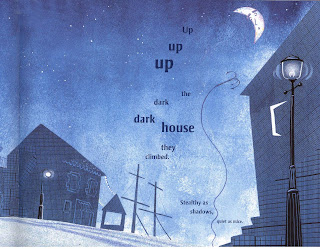In his article '
Led Creatively by the Book' in the Carousel Guide, Chris Stephenson writes: 'The body and soul of a picture book - illustrations, text, type design - should all evolve together.’
This is exactly what I wanted to do when I started working with typographic designer Lisa Kirkham,
and The Little White Sprite, with the tree dominating the page lent itself to the close interlacing of twigs, typeface and story.
Starting with a rough like the one above, where the text was all in a block, we would work together positioning it into a more organic shape –
We were coming from different directions and that was exciting. Whereas I was used to thinking broadly about the picture book’s overall rhythms – the punctuation of page turns to create pause and suspense in a story, Lisa’s decisions were informed by the reading movement of the eye. The placement of text and type design was like a form of visual intonation with spaces for breaths.
For example, words in a sentence singled out and moved to another line, like ‘a hole’, catch the eye and are given emphasis. We had to decide whether the emphasis was appropriate for that bit of the story.
Whereas I might find a particular pattern of text, like that on the right hand page above, pleasing to the eye, I was having to learn to use my ears as well as my eyes when it came to very precise placing of text. There was something too staccato about the line separation of the words ‘tugging’ and ‘at me’ and, in the end, we put them on the same line to lessen the effect.
This is all very subtle and probably passes unnoticed by the reader, but if it contributes unconsciously to a harmony in the book between eye and ear, then it’s worth doing.
Lisa and I are giving a workshop, Creative Use of Typography in the Children’s Book on 21 May 2011 as part of the SCBWI Illustrator Master Class series -
And finally, Chris in his article mentions all the people who have helped Plaister Press come about. I’d like to add his name to that list with a big 'thank you' for his unwavering belief in the success of our venture.

















































